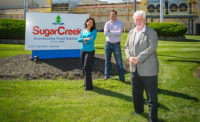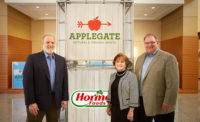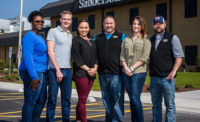Leave it to science to find a way. The pork industry’s decision to convert to sow housing in recent years had been driven predominantly by the ethical concerns of consumers and end users, but scientific research may yet help producers transition more easily to group housing and handle the new set of challenges it brings.
Several years ago, The National Provisioner featured a unique funding program started by Oscar Mayer (now a part of Kraft Heinz) that helped the University of Wisconsin-River Falls (UWRF) develop and implement animal-welfare curriculum and courses. Since then, the program has grown to fund several other projects, including in-depth research on sow aggression in group housing at The Ohio State University Swine Facility in Columbus, Ohio, led by Monique Pairis-Garcia, assistant professor of animal welfare & behavior.
Larry Sadler, associate director of animal welfare for Kraft Heinz, says the goal of the program hasn’t changed.
“We’re always trying to figure out the best way that we can assist and impact [the industry],” he says. “The research that’s been funded already is continuing and seems to be really valuable in helping to support the industry in sustainable welfare.”
In addition to funding the UWRF program and the OSU research project, Kraft Heinz has lent its support to the University of Pennsylvania, where researchers are developing tools for animal-welfare assessment and sow housing, and the University of Guelph in Canada — a jointly funded program with National Pork Board to study pain mitigation in swine. Sadler says each of these fits the criteria Kraft Heinz was seeking.
When the OSU Swine Facility converted to sow group housing, the farm encountered many of the same growing pains as any commercial facility would when making the transition.“With the OSU project in particular, we were looking for a partner that was working on sow housing and … specifically someone new into the animal-welfare field,” he says. “Dr. Pairis-Garcia was really that ideal candidate, being a new animal-welfare specialist here at OSU and then also working on sow housing.”
Pairis-Garcia relays that the timing couldn’t have been better, as the university swine facility had just retrofitted its sow barn to a three-pen group housing system, and interest in welfare research existed within the department, and among the students and swine producers of Ohio.
“[Ohio] producers are required to transition to sow group housing by 2025 based on the Ohio Livestock Care Standards,” she explains. “So for me, this was a project that not only could get students at the university involved, but it would be valuable information that would provide science-based guidelines to producers in Ohio and those making the transition to group housing elsewhere.”
When the OSU Swine Facility converted to sow group housing, the farm encountered many of the same growing pains as any commercial facility would when making the transition. This included one of the biggest challenges associated with group housing: sow aggression.
“Sows will fight and hurt each other [in a group housing setting] in order to determine a hierarchy of dominance,” she explains. “That is why focusing on research to help mitigate sow aggression in group housing systems is so important.”
So Pairis-Garcia and her team set up a study to record, review and attempt to understand aggressive sow behavior and use this information to identify solutions to curb that aggression. Observation of the sow behavior began in December 2015 and wrapped up in August of this year.
“Our project consisted of putting sows into group housing, video-taping their behavior and watching how aggression changed over time — then using this information to better understand how we might … mitigate or temper that behavior,” she says. “We’re not going to stop them from being aggressive, but we can try to get them to like each other just a little bit more.”
Magnus Campler, animal welfare specialist at OSU, found video equipment that would work well in a swine facility — recording day and night, all angles of the pen — and the team developed a method by which aggression would be observed, scored, tracked and analyzed, using behavioral observation software originally designed for human behavior studies.
The software allows an observer to view the recorded video and enter aggression incidents with one or two clicks of the keyboard, rather than having to write down every incident of aggression or put it into a spreadsheet, which can be time-consuming. The observer watches the video one time per sow (each has a number), focusing only on the assigned animal’s movements and actions — at the OSU Swine Facility, 20 sows took up residence in the group housing pen, so each video was observed 20 times. If the observer is watching sow No. 10, and she starts a fight with sow No. 18, all that person has to do is push a button for the type of aggression, and the software records and archives the rest of the information.
Using the videos and software, the team was able to rank sows in three groups: subordinate, subdominant and dominant. Then, they could look at how those rankings affected the “social network” of the pen as time progressed — which sows commandeered the best spots to lie down, which sows fed more quickly or ate more, which sows attempted to displace other sows who had taken up residence in the automatic electronic feeder, and what injuries could be prevented in the event of aggression?
“With sow housing transitioning in the United States, we’re going to really start seeing the bigger picture change toward how we change the sow to be a better fit for group housing than a stall.”— Pairis-Garcia
Understanding sow aggression isn’t the only way to make the transition to group housing a bit smoother,” says Pairis-Garcia. The OSU team found that slight alterations in the facilities or equipment could prevent some injuries sustained during sow fighting. For example, old, worn concrete became quite a problem for sows, says Steve Moeller, professor of animal science at OSU who is also part of the swine extension program. So a change had to be made.
“We went in and put rumble strips, [scarred the concrete] around the feeder, that would give them better traction,” he explains. “I think it has made a difference in reducing the slips and falls, so they have better footing in and out of the feeder.”
Changing the configuration of the pen itself also may lead to fewer aggressive interactions among sows and therefore fewer injuries. This includes looking at the type of space provided to the sows, says Pairis-Garcia.
“You need to have [enough] quality lying space — it’s not just about having a feeder and enough square footage [per sow], but actually having places for them to lie down and get away from each other,” she says. “We have worked with experts in the field of group housing to help our farm better utilize the space by providing divisions for hiding and adequate space to lie down.
“All these solutions have come from the goal to improve sow welfare in group housed systems and realizing that group housing goes way beyond simply buying a feeder,” Pairis-Garcia adds. Campler says the industry is still on a learning curve here, but the stakeholders are working hard to get best practices sorted out.
“There’s probably not one way to do it, but there are some ways not to do it,” he says. In the short term, Pairis-Garcia hopes students can use the research they’ve done on sow aggression to help change industry best practices on facility design. Long term, however, she aims to apply some of the changes to the larger commercial facilities in the industry, and also to look at the genetics behind aggression.
“What I’d really like to see is, can these aggressive behaviors be minimized using genetic selection while still maintaining good production and efficiency?” she concludes. “With sow housing transitioning in the United States, we’re going to really start seeing the bigger picture change toward how we change the sow to be a better fit for group housing than a stall.”
As that process evolves over time — led by researchers like Pairis-Garcia and her team, backed by industry investors like Kraft Heinz — well-researched, tested, scientific solutions could make sow group housing an easier pill to swallow for producers. NP









